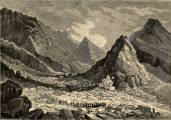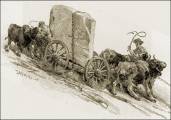


Appalachia: Problems and Opportunities
Opportunities for Mineral-Based Industry in Appalachia
The opportunities for new and expanded manufacturing based on indigenous mineral resources in Appalachia are both diverse and bright. Several of the minerals most important to industrial development are already being produced in Appalachia (fig. 1) and, as will be shown in subsequent sections of this report, the known resources of many of the commodities that underpin manufacturing, construction, and transportation are adequate to support expanded production. There is in addition a substantial potential for new discoveries of these and other mineral resources that could further diversify the base for industry in many parts of the region. Full realization of Appalachia's resource potential will require a far better knowledge of its geology than is available now and considerable advance in many phases of mineral technology. Work in these areas should be accelerated now; however, presently known and minable deposits are ample to support industrial development in many parts of Appalachia.
In examining the opportunities for industrial development, Appalachia must be considered in terms of component regions and the areas surrounding them. Appalachian products will compete in areas adjacent to their manufacture both inside and outside its boundaries. The magnitude of the outside market that Appalachian products could hope to capture has not been determined, but it is worth noting that there is now within Appalachia a deficiency in retail sales of $4 billion a year, measured on a per capita basis, compared to the rest of the United States. This sum is a gauge of the size of the retail market that new income in Appalachia would generate, and a substantial part of this market should be captured by new or expanded Appalachian industry.
Detailed analysis of potential markets in and near Appalachia has not yet been made, but something of the industrial potential that Appalachia's mineral resources might support are briefly indicated here in terms of major groups of commodities. Detailed information on the production, distribution and resources of individual minerals is presented later in the "Mineral Commodities" sections of this report.
Figure 1. Mineral commodities produced in the Appalachian Region in 1964 (values shown in 1958 constant dollars). Source: U.S. Bureau of Mines. (Resources listed in the figure: Bituminous coal, petroleum and natural gas, stone, anthracite, cement, sand and gravel, zinc, lime, clays, salines, dimension stone, and others.)
Sand and gravel, stone, other rocks and minerals and cement, used mainly for construction, now make up Appalachia's third largest group of mineral industries. Usable deposits are scattered throughout Appalachia and are extensive enough to support greatly expanded highway, industrial, and urban construction in and adjacent to all parts of the region. Most of these materials have such low unit value that it is impractical to transport them long distances, but Appalachia's own needs for new construction are so great that the industry should grow rapidly. Indigenous resources are adequate to support increased production also of some higher value materials such as roofing granules, lightweight aggregate, marble, and terrazzo..
If this section seems to be an optimistic description of the possibilities for economic development in Appalachia, it is because that is its very purpose. The industrial economy's high tower of income is literally built from sand and clay-and a host of other prosaic ingredients that are worthless in their raw state. But before these raw materials are taken from the ground, their possible presence has to be recognized and the conviction must form that something useful can be done with them. Economic development generates from the desire for economic change and betterment, linked to intelligent but nevertheless optimist, imaginative, and venturesome enterprise. The grist for the development mill comes from the earth, but it is the human activities that make the mill turn.
Grist is readily available in Appalachia but its abundance obviously has not led to full development. Terrain was the initial inhibitor of development, and remains a hindrance. Accumulated damage to land and water from mining and acid mine drainage is extensive, and its repair will add to the development costs. Educational levels need to be bettered and part of the working force must be retrained. Even though these and other obstacles to economic development are large, they are not insurmountable. Technologic advances that have made terrain mitigation feasible coupled with Appalachia's rich natural-resource base are the makings of a viable, self-sustaining productive economy in Appalachia, and accelerated economic development is a realistic goal.
Commercial use of material within this site is strictly prohibited. It is not to be captured, reworked, and placed inside another web site ©. All rights reserved. Peggy B. and George (Pat) Perazzo.
